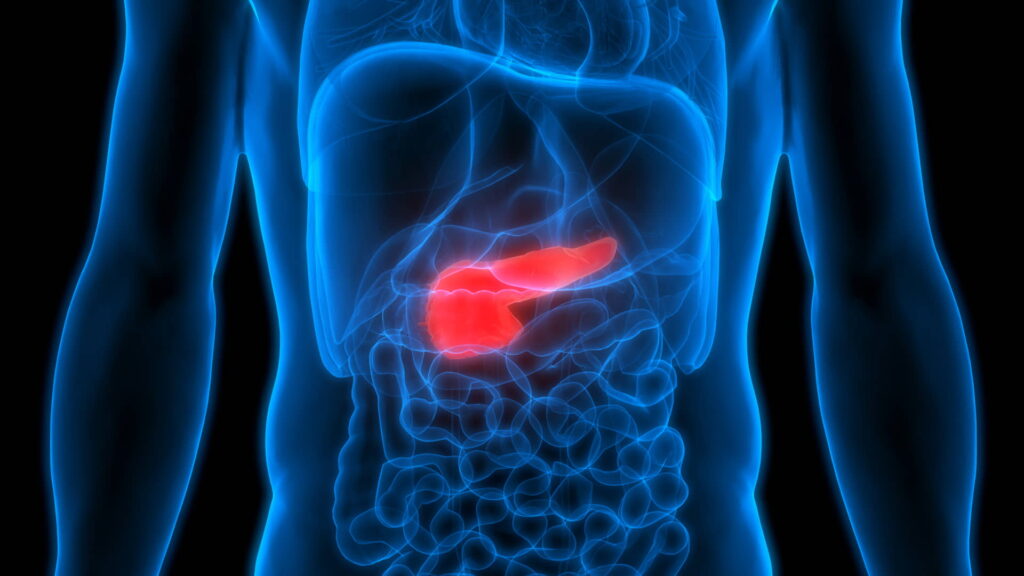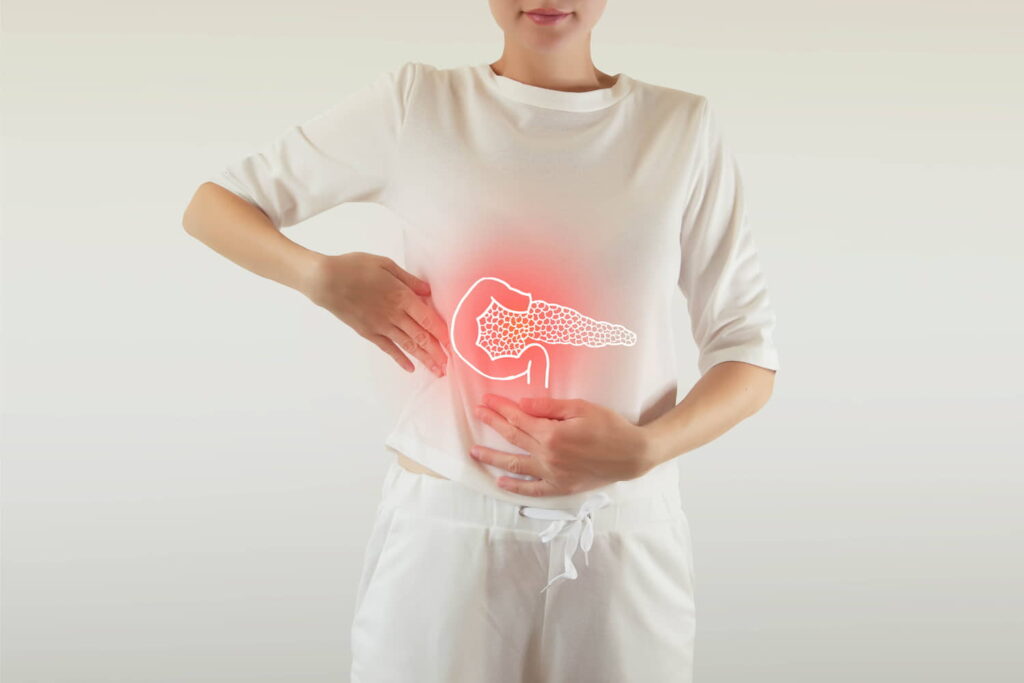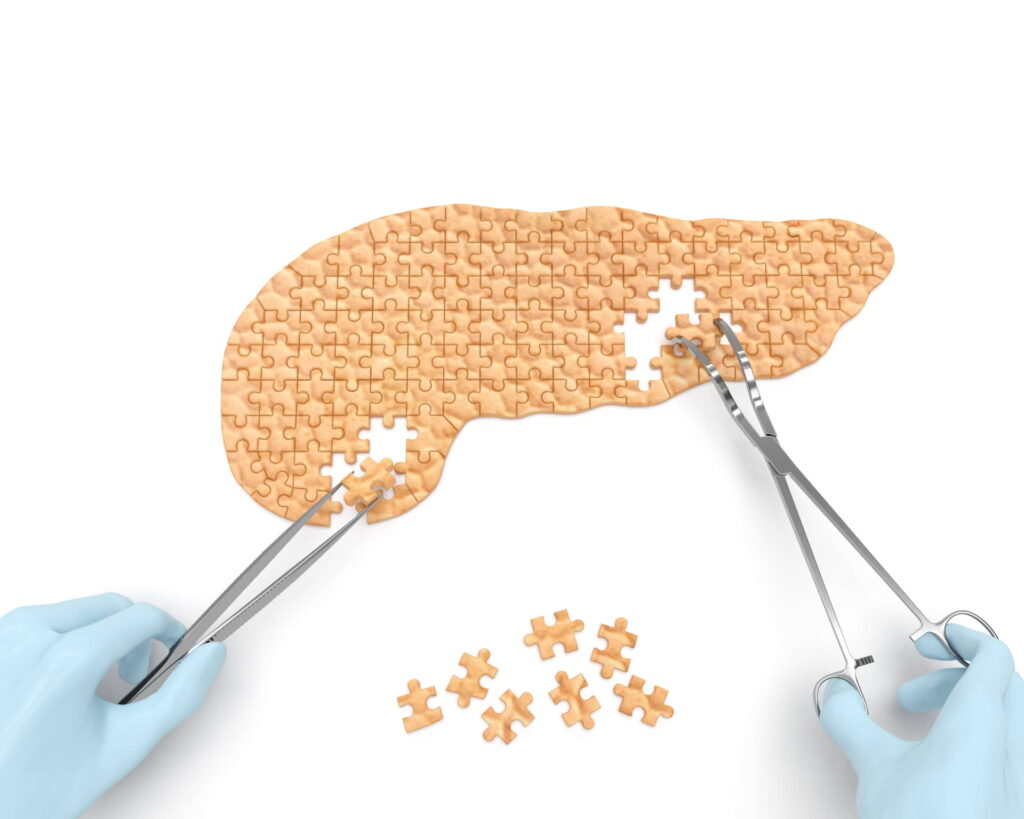
Pancreatic Cancer
Understanding the causes and symptoms of pancreatic cancer for effective prevention and treatment to improve the survival rate
Pancreatic cancer is the fifth deadliest cancer in Hong Kong. It begins with the mutation and proliferation of cells in the pancreas. The detection of pancreatic cancer is difficult as the pancreas is located deep inside the abdominal cavity and is asymptomatic at the early stage. As a result, pancreatic cancer is usually diagnosed at an advanced stage when treatment is difficult, leading to a lower survival rate. Treatment for pancreatic cancer includes surgery, chemotherapy, radiotherapy and targeted therapy.

Survival Rate for Pancreatic Cancer
Although pancreatic cancer has a lower incidence rate compared with other cancers, it is terrifying since its incidence rate is almost equal to the death rate. The two main reasons are the difficulty of early detection and the high recurrence rate. As the pancreas lies behind the gastrointestinal tract, it is not easy to carry out screening tests. In addition, pancreatic cancer is almost asymptomatic at the early stage. Even if symptoms do appear, they are easily mistaken as gastrointestinal discomfort and ignored. According to clinical statistics, up to 85% of the patients are diagnosed at an advanced stage and cannot undergo surgery. Although the remaining 15% can undergo surgery, 80% of them will suffer from recurrence. Therefore, diagnosed patients have a low survival rate and shorter survival time compared with patients with other cancers.
Causes of Pancreatic Cancer
The cause of pancreatic cancer is still not completely known, but is believed to be originated from the mutation and proliferation of cells in the pancreas. Several risk factors may increase the chance of developing pancreatic cancer.
- Age: People over 65 years old have a higher risk
- Gender: Men have a higher risk than women
- Smoking: The chance of developing pancreatic cancer for smokers is 2 to 3 times higher than that of non-smokers
- Abnormal glucose metabolism: Diabetes increases the risk of developing pancreatic cancer
- Overweight: Overweight people have a higher risk
- Unhealthy diet: Long-term consumption of animal fat and the lack of fruit and vegetables will increase the risk of developing pancreatic cancer.
- Exposure to chemicals: Prolonged exposure to pesticides, petroleum or dyes will increase the risk of developing pancreatic cancer.
- Chronic pancreatitis: Can be diagnosed together with pancreatic cancer
Symptoms of Pancreatic Cancer
The pancreas is located in the upper left abdomen between the stomach and the spine, and surrounded by the liver, gallbladder, spleen, and small intestine. Because of its hidden location, early-stage pancreatic cancer usually has no obvious symptoms or even no symptoms at all. As the disease develops, the following symptoms may appear:
- Dark urine, light-coloured stools (clay-coloured), occasional diarrhoea
- Jaundice(yellowing of the skin and eyes)
- Pain in the upper abdomen also the middle of the back that cannot be relieved despite change of posture
- Nausea, vomiting and weakness or extreme fatigue, dizziness and chills
- Loss of appetite or bloating
- Unexplained weight loss
Patients may easily mistake these symptoms for common gastrointestinal discomfort and miss the best timing for treatment.

Screening of Pancreatic Cancer
The doctor will first conduct an initial examination by evaluating the patient's medical history and performing a physical examination. The examination includes observing the whites of the patient's eyes and skin for any signs of yellowing and pressing the abdomen to observe any pain. Further tests and tumor diagnosis will be performed if necessary.
Diagnosis of Pancreatic Cancer
胰臟癌診斷方法包括︰驗血、腹部超聲波掃描、電腦斷層掃描、磁力共振掃描、內窺鏡逆行膽胰管造影、磁力共振膽胰管攝影、活組織檢查。醫生會根據診斷檢測結果為患者的病情分期,再決定採用哪個癌症治療方式。
- Blood Test
Blood tests are performed to check the number and shape of the blood cells, and the function of the liver and kidneys. The risk of pancreatic cancer can be determined by testing the concentration of specific proteins in the blood.
- Abdominal ultrasound imaging
An abdominal ultrasound machine can be used to observe organs in the upper abdomen such as the liver, pancreas, gallbladder, and bile ducts. It will emit ultrasound waves to the organs, then the reflected waves will be converted by a computer into an image. Doctors may also use an endoscope with an ultrasound probe to increase the resolution of the images.
- Computed tomography scan (CT scan)
A CT scan generates X-ray images of body tissues from different angles to analyse the location, size, and distribution of the tumor, and its possible effects on the surrounding blood vessels, lymphoid tissues and organs.
- Magnetic Resonance Imaging (MRI)
A magnetic field is used to create a cross-sectional image of the body to observe any carcinogenesis of the pancreatic duct.
- Endoscopic retrograde cholangiopancreatography
Commonly known as “ERCP”, the procedure combines endoscopy with X-ray imaging to obtain images of the stomach and upper gastrointestinal tract. A contrast agent is injected into the pancreas and bile ducts for easy visualisation under radiography.
- Magnetic resonance cholangiopancreatography (MRCP)
MRCP uses magnetic resonance imaging to scan and detect any blockage of the junction of the bile duct and pancreatic duct from the outside.
- Biopsy
In a fine needle aspiration (FNA) biopsy, the doctor will insert a thin needle into the tumor guided by ultrasound or a CT scan. Cell samples will be collected for further diagnosis using a microscope.
Based on the results of the tests, the doctor will do cancer staging to determine the best treatment modality.

Treatment of Pancreatic Cancer
The treatment of pancreatic cancer depends on the stage of cancer, the patient's age, overall wellness, and personal preference. The primary goal of the treatment is the complete removal of tumors. If this is not feasible, the focus will be on delaying the tumor development or avoiding further damage. Therefore, in certain circumstances, palliative treatments will be the most suitable for particular patients.
- Pancreaticoduodenectomy (Whipple operation)
This is the most common and the only surgery that can cure pancreatic cancer. It involves the removal of certain parts affected by the tumor such as the pancreas, duodenum, gallbladder, and even part of the stomach. The surgical mortality rate is less than 5%. About a quarter of patients have pancreatic cancer in the body or tail of the pancreas. As they are diagnosed at an advanced stage, a distal pancreatectomy or a total pancreatectomy is required.
- Radiotherapy
Radiotherapy utilizes high-energy radiation to destroy cancer cells and can be administered after cancer surgery. When the patient is not suitable for surgery, the doctor may recommend the use of radiotherapy and chemotherapy simultaneously.
- Chemotherapy
Chemotherapy is the use of drugs to kill cancer cells usually via intravenous injection or oral consumption. The drugs will attack the tumor with a larger affected area after entering the bloodstream. Although chemotherapy alone cannot eliminate cancer cells completely, it can relieve symptoms and improve the patient’s quality of life. Chemotherapy can also be used as adjunctive therapy after the surgical removal of the pancreatic tumor.
- Targeted Therapy
Targeted therapy directly addresses the mechanism of cancer cell mutation, proliferation, and metastasis by inhibiting the growth and repair of tumor cells via drugs. However, most of the targeted therapy drugs for pancreatic cancer are still in the clinical trial stage and are self-financed items in hospitals under the Hospital Authority.

Recovery and Rehabilitation of Pancreatic cancer
Patients should arrange regular follow-up consultations to allow the doctor to monitor their condition and evaluate the risk of recurrence. If patients experience any discomfort, they may undergo further examinations according to the doctor’s advice to identify and treat the cause of discomfort as timely as possible.
- Regular check-ups
Patients should pay attention to their physical condition. If symptoms such as abdominal or back pain, unexplained weight loss, jaundice, nausea and vomiting arise and persist for a period, they should immediately seek further medical examination to confirm whether pancreatic cancer has recurred.
- Pay attention to diet
Patients should pay attention to their diet because the pancreas is an important digestive organ. They should maintain a diet consisting of small, frequent meals, and higher consumption of beans, cabbage and broccoli. Avoid carbonated drinks to reduce intestinal gas.
Prevention of Pancreatic Cancer
As long as pancreatic cancer is detected early and treated in time, the overall survival rate can still be improved.
- Maintain healthy living and dietary habits
Consume more high-antioxidant food such as different types of fresh fruits and vegetables every day. Selenium-rich food such as grains, beans, mushrooms, and seafood can reduce the burden on the body. Consume less meat skin, sauce, high-sodium food, sugary drinks and sweets.
- Maintain sufficient daily calorie intake and have regular meals
You should maintain sufficient daily calorie intake every day to meet the needs of the body. Once the body lacks calories, it will mistakenly break down muscles to make up for the caloric needs. This can lead to insulin resistance and damage the pancreas. Having regular meals can stabilize the secretion of digestive juices and maintain endocrine balance, a stable blood sugar level and a calm mood.
- Consume more high-antioxidant vegetables and fruits
Vegetables and fruits with vitamins A, C, and E and selenium are effective in inhibiting oxidation. It is recommended to consume different kinds and colours of vegetables and fruits every day. Selenium-rich food such as grains, beans, mushrooms, and seafood can reduce the burden on the body.
- Quit smoking and avoid second-hand smoke
Smoking increases the risk of having pancreatic cancer since the inhaled nicotine will circulate throughout the body via the bloodstream. It hinders the secretion of digestive enzymes from the pancreas and other digestive organs, causing indigestion and inflammation, which can easily lead to pancreatic cancer and duodenal ulcer. Second-hand smoke and third-hand smoke also have the same harmful effects and should be avoided.
Pancreatic Cancer FAQ
Q. Where is the pancreas?
The pancreas is located deep in the abdomen. A part of the pancreas lies between the stomach and the spine, while the other part is found in the curvature of the duodenum (the first part of the small intestine). Because of its deep location, most pancreatic tumors are not palpable when applying pressure to the abdomen. In addition, pancreatic cancer usually has no symptoms until the tumor begins to interfere with the function of the pancreas or other nearby organs, such as the stomach, duodenum, liver, or gallbladder. These lead to the late diagnosis of cancer.
Q: Is it possible to cure pancreatic cancer under early diagnosis?
Although the overall prognosis of pancreatic cancer is poor and the disease is mostly incurable, it is potentially curable if detected early. Up to 10% of the patients who receive an early diagnosis remain disease-free after treatment. (Quoted from The Johns Hopkins University)
Q: What is the function of the pancreas?
The pancreas plays an essential role in the digestive system, and also controls endocrine functions such as regulating blood sugar levels. The digestive system normally works in this way: the food flows from the mouth to the stomach through the oesophagus and then is broken down by stomach acid. The partially digested food flows directly into the first part of the small intestine (duodenum). Bile from the liver and digestive enzymes from the pancreas enter the digestive system in the duodenum. The duodenum leads to the rest of the small intestine, where the food will be further digested and then delivered to the large intestine (also known as the colon). Lastly, the fully digested substance (our poop!) passes through the anus to defecate.
References
1. 癌症基金會:《認識癌症:胰臟癌》
https://www.cancer-fund.org/wp-content/uploads/2017/04/pancreas-june17C.pdf
2. https://www.liver.org.tw/journalView.php?cat=61&sid=783&page=1
3. https://www.cancer.gov.hk/tc/hong_kong_cancer/cancer/cancer_fatal.html



